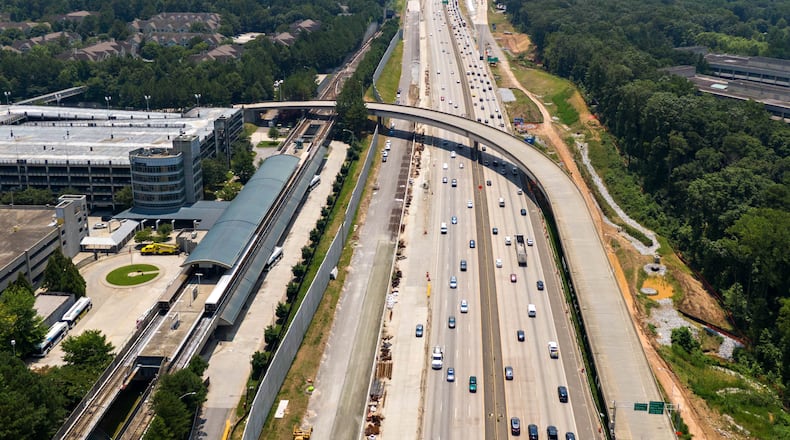Georgia officials have reshuffled their plans for major highway construction projects in metro Atlanta, delaying some work and allowing private companies to set tolls on some new lanes.
The timeline for new toll lanes on the Perimeter and Ga. 400 will be pushed back, though it’s not clear how long. So will a new I-285 interchange at I-20 west of Atlanta and truck lanes on I-75 between McDonough and Macon. It’s the second time in recent years the Georgia Department of Transportation has shifted procurement schedules for the projects.
The state also plans to allow a private company to set toll rates and collect the revenue from the Ga. 400 lanes. It announced similar plans last summer for the Perimeter toll lanes.
GDOT officials say spreading the projects over a longer period will benefit taxpayers by encouraging more companies to compete for the work. And they say the new financing approach to the toll lanes will stretch tax dollars further by encouraging private investment in major highway projects.
“This is the biggest (highway construction) program in the nation,” GDOT Commissioner Russell McMurry told The Atlanta Journal-Constitution. “We have to continue to adjust and be responsive to what’s in front of us.”
It’s the latest shake-up for a 10-year, $10 billion plan unveiled in 2016 to improve Georgia highways. In metro Atlanta, that plan includes 40 miles of toll lanes on the top half of I-285, 16 miles of toll lanes on Ga. 400 and new I-285 interchanges at I-20 east and west of the city. It also includes 40 miles of trucks-only lanes on I-75 south of Atlanta.
The timeline for the projects began to slip in 2019, when GDOT announced some would be pushed back and others accelerated. More changes came last year.
In June, GDOT announced it would seek private investment in its $6.1 billion effort to build toll lanes on the Perimeter. In exchange, GDOT will allow the selected firm to set tolls for the new lanes and collect the revenue for 50 years. The state sets the price on metro Atlanta’s existing 67 miles of toll lanes.
GDOT says the private investment will allow it to build more lanes than originally planned. But the new approach also delayed the construction timeline, and a private firm might charge higher tolls than the state to earn a profit.
Meanwhile, in August the State Transportation Board rejected the lone responsive bid to build the Ga. 400 toll lanes because it far exceeded the agency’s $1.7 billion budget. The timetable for the project is uncertain.
Now GDOT has announced a new project schedule:
Credit: HYOSUB SHIN / AJC
Credit: HYOSUB SHIN / AJC
Ga. 400 toll lanes: GDOT will select a developer for the project in August 2023 — two years after it rejected the last bid under its initial plan. The agency has not announced a new construction schedule. The lanes were previously set to open in 2027.
GDOT also has decided to allow a private firm to operate the Ga. 400 toll lanes, taking the same approach it plans for the Perimeter lanes. McMurry said private investment will improve the project — including plans for bus rapid transit in the new lanes.
I-285/I-20 west interchange: GDOT will select a contractor in mid-2024 — 1 1/2 years later than previously scheduled. As with the other projects, GDOT has not announced a new construction timetable.
Credit: HYOSUB SHIN / AJC
Credit: HYOSUB SHIN / AJC
East-side Perimeter toll lanes (I-20 east to Raider Drive): The scope and schedule of GDOT’s plans to build toll lanes on the top half of the Perimeter have changed substantially. Initially, the Perimeter lanes were to be divided into three projects — east side, west side and top end. Now they’ll be divided into two sections — east and west.
But the first “east side” contract would cover only the stretch from Raider Drive to North Shallowford Road on the top end, plus Ga. 400 up to the North Springs MARTA station. Additional segments would be negotiated with the contractor later, though the timetable has not been determined.
GDOT will solicit developers for the first segment in mid-2023 — two years later than previously scheduled. The east-side lanes were previously set to open in late 2028.
West-side Perimeter toll lanes (I-20 west to Raider Drive): GDOT plans to solicit firms in late 2024 — a year later than previously scheduled. Like the east-side lanes, the initial contract will cover only one segment of the project — from Raider Drive to Atlanta Road — with additional segments to be negotiated later.
The west-side lanes were previously set to open in 2032.
Credit: HYOSUB SHIN / AJC
Credit: HYOSUB SHIN / AJC
I-75 truck lanes: GDOT plans to select a contractor in late 2026 — 3 1/2 years later than previously scheduled. Under the previous timeline the lanes were to open in 2028.
GDOT officials say the new schedule will encourage competition by spreading the projects out and allowing more companies to bid. They say other factors — including inflation and labor shortages caused by COVID-19 — also affected the schedule.
McMurry said he understands the projects can’t happen fast enough.
“These are multibillion-dollar projects that are transformative for metro Atlanta and Georgia,” he said. “We have to be very deliberate and thoughtful in how we advance these.”
New schedule for big projects
The Georgia Department of Transportation will push back the timeline for several metro Atlanta highway construction projects:
- Ga. 400 toll lanes
- I-285 toll lanes
- I-285/I-20 west interchange
- I-75 truck lanes
About the Author
Keep Reading
The Latest
Featured







